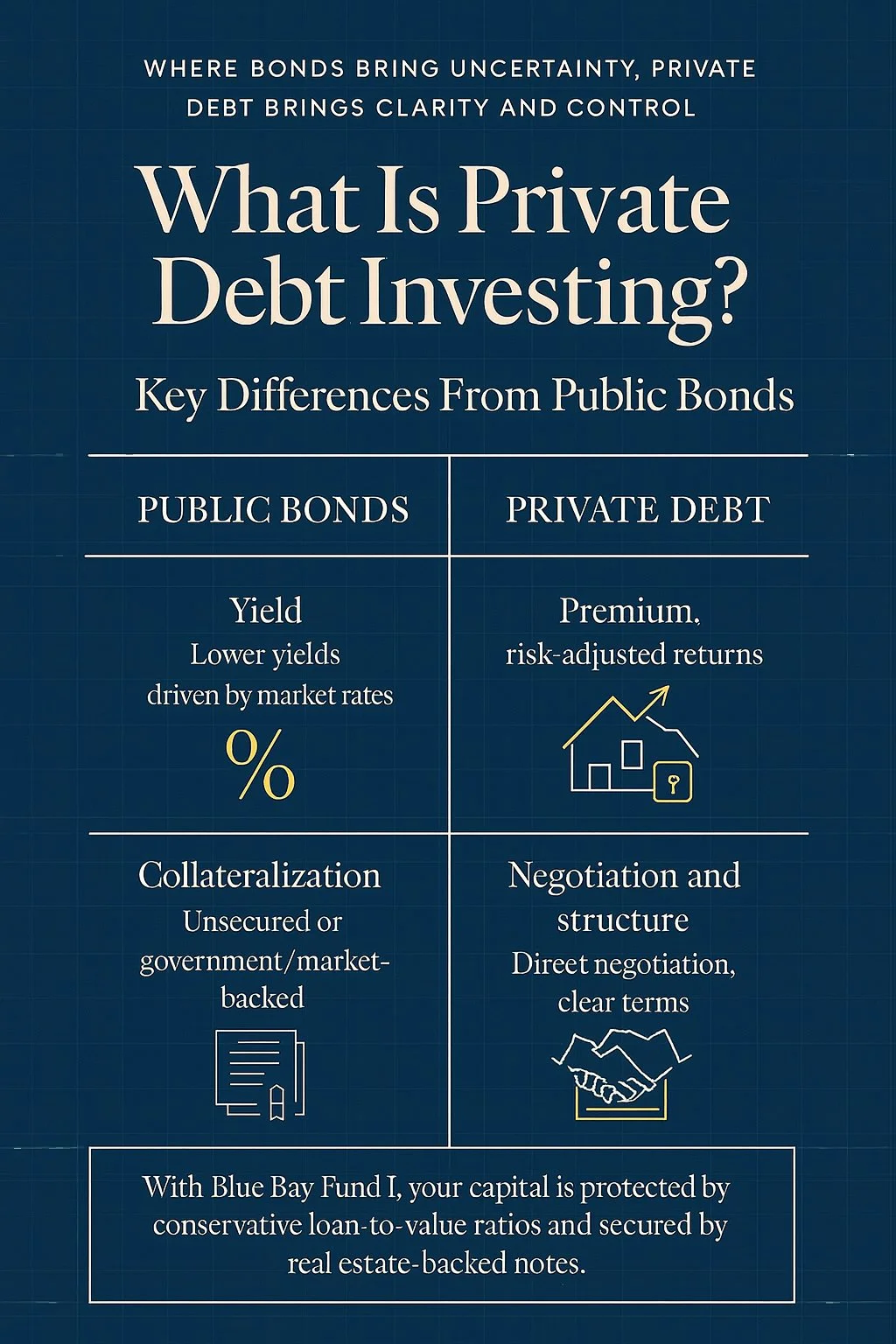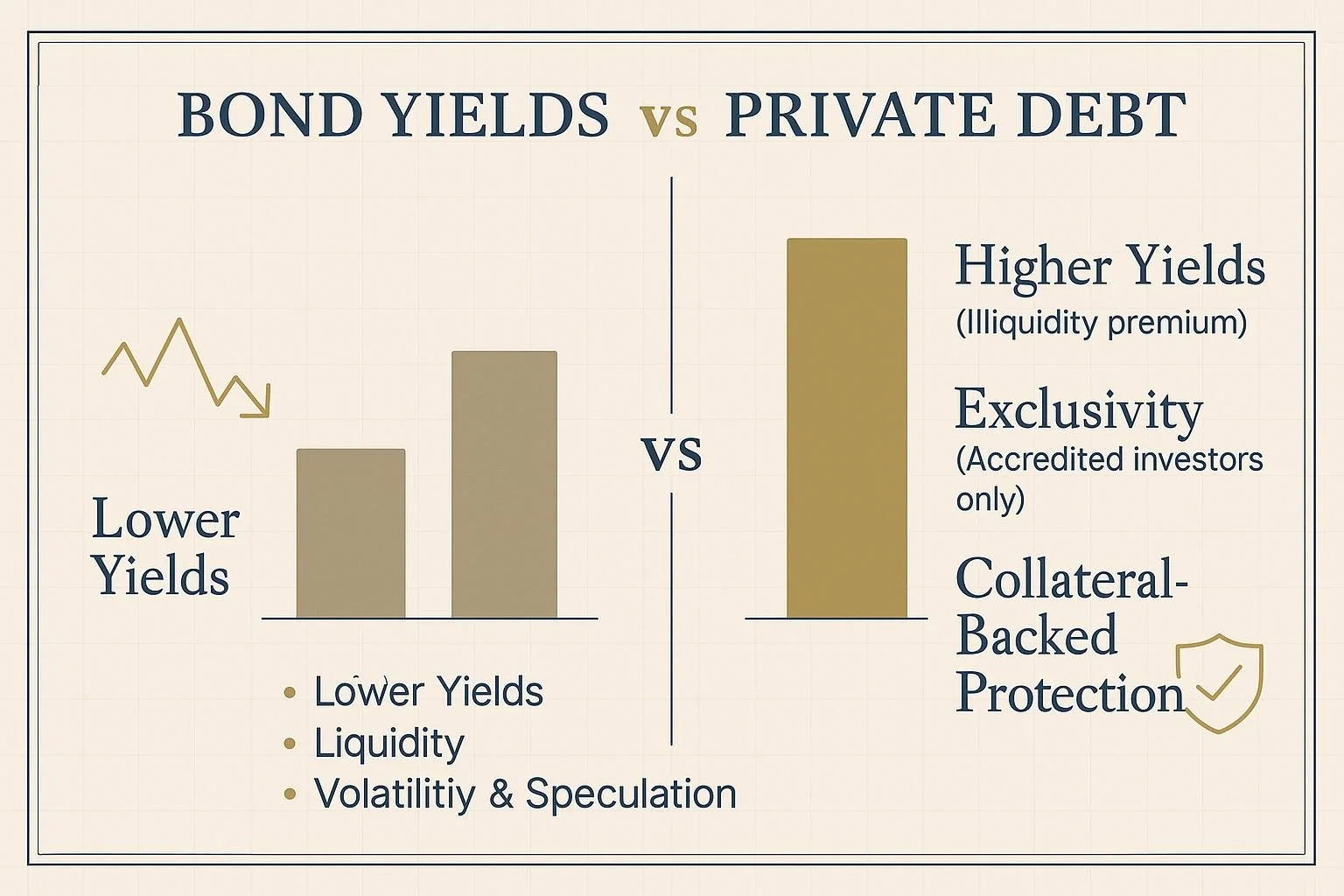Private Debt Investment: Reliable Returns, Enduring Legacy
Introduction
If you’re tired of Wall Street’s volatility, hidden fees, and vague opportunities, private debt investment offers an alternative path. For accredited investors like Rick and Jessica, this strategy provides what public markets cannot: transparency, consistent income, and control over your capital. This article explores what private debt is, how it works, and why it's a cornerstone for legacy-minded investors seeking yield and peace of mind, guided by experienced fund managers.
Lose sleep with Wall Street. Rest easy with private debt.
About the Fund Manager
Edwin D. Epperson III, Founder & Investment Manager, Blue Bay Fund I Former U.S. Army Green Beret with 13+ years of experience underwriting private credit. Edwin has deployed $35M+ across 170+ secured, property-backed investments, specializing in first-position mortgage notes with conservative loan-to-value ratios. He invests alongside clients, ensuring alignment and stewardship.
What Is Private Debt Investing?
Public Bonds vs. Private Debt.
Private debt investing means lending directly to real estate businesses through secured strategies like Blue Bay Fund I. Instead of buying public bonds, investors provide capital through private loans backed by property. These loans usually have conservative loan-to-value ratios and tangible collateral.
To learn more, see How to Invest in Private Debt.
Key Differences From Public Bonds
Negotiation and structure – Terms are set by our team and the project investor, secured by a mortgage or deed of trust.
Collateralization – Loans are secured by real estate.
Premium returns – Secured and risk-adjusted opportunities reward investors with higher yields.
Where bonds bring uncertainty, private debt brings control
How to Invest in Private Debt (Step by Step)
Private debt may sound complex, but the path is straightforward when you know what to look for:
Steps for Accredited Investors
Identify opportunities – Focus on conservative, collateral-backed loans or funds such as first-position mortgage notes.
Evaluate investment management firms – Seek firms and funds where the investment management team has “skin in the game,” a strong track record, and transparent reporting.
Review the terms – Understand yields, maturities, covenants, and liquidity windows.
Commit capital – Accredited investors typically start with a $50K+ allocation, with additional investment options from $1,000.
Monitor results – Expect consistent reporting via monthly investor portal updates, quarterly team updates, and direct access to our investment management team.
Choose private debt: stability over speculation
Why Private Debt Investments Appeal to Accredited Investors?
Private debt isn’t just another asset class; it’s a tool that enables your desired lifestyle and legacy. While offering many benefits, it's also important to understand the Risks and Considerations.
Core Benefits:
Private debt provides a consistent monthly income to fund travel, generosity, and family time.
It safeguards wealth through capital preservation, protecting against inflation and volatility.
Transparency and control are built into every deal through clear underwriting and collateral-backed terms.
For faith-driven investors, it reflects biblical stewardship by aligning resources with values.
It also represents one of the most attractive passive income alternatives for accredited investors today.
Trusted Stewardship for Your Legacy
Edwin D. Epperson III has deployed more than $35M across 170+ property-backed investments for over a decade. With a disciplined focus on conservative underwriting, first-position liens, and low loan-to-value ratios, Blue Bay Fund I delivers predictable cash flow and transparency. Investors gain the confidence of working with an investment management expert who prioritizes stewardship and alignment by investing alongside clients.
Is Private Debt an Alternative Investment?
Yes. Private debt is part of the alternative investment industry, alongside private equity and real estate. However, unlike speculative alternatives, it is rooted in tangible collateral and disciplined underwriting.
For Rick, this means reliability during semi-retirement. For Jessica, it provides confidence that her wealth is stewarded responsibly. Both see private debt alternative investment as a way to maintain independence, clarity, and legacy.
When markets shake, private debt stands firm.
Private Debt vs. Traditional Fixed Income
Private debt investing offers accredited investors distinct advantages over bonds or treasuries. Yields are generally higher due to the illiquidity premium. Access is exclusive and reserved for accredited investors who can participate in carefully underwritten deals. And while traditional bonds may offer liquidity, private debt provides risk-adjusted protections with collateral-backed structures.
In short, public fixed income markets often expose investors to speculation and volatility, while private debt delivers yield, clarity, and control; the very qualities that conservative investors value most.
Sleep soundly knowing your wealth is protected and working for you
Protecting Wealth, Preserving Legacy
Risks and Considerations
No investment is without risk. Accredited investors should carefully weigh three primary factors of debt fund investing: leverage risk, liquidity risk, and economic cycles. Borrowers may default, though collateral helps protect principal. Capital may be tied up during the loan term, limiting liquidity. And recessions can place downward pressure on repayment schedules.
Mitigation strategies include working with experienced investment management professionals, diversifying across multiple loans, and laddering maturities to balance income and flexibility.
FAQ
Is private debt a good investment for accredited investors?
Yes. For those prioritizing passive income, capital preservation, and legacy, private debt investment provides a secure, collateral-backed alternative.
How do private debt funds work?
Blue Bay Fund I’s Customizable Fund(™) pools capital from accredited investors and lends it to real estate investment businesses and developers. Investors earn returns through structured interest payments and eventual principal repayment.
What makes private debt safer than other alternatives?
Conservative underwriting, collateral-backed loans, and transparent reporting reduce risks and create clarity for investors. These structures are often referred to as secured credit funds.How can private debt support legacy goals?
By generating consistent income, it helps fund family security, charitable giving, and long-term stewardship.
Conclusion
Private debt investing is more than an asset class. It’s a disciplined, stewardship-driven strategy that aligns with the values of accredited investors like Rick and Jessica. It provides income to enjoy today, protection for tomorrow, and legacy for generations. For more details, please refer to our FAQ section.
Manager’s Note:
“Stewardship guides every decision we make. Our aim is simple: secured income, clarity in reporting, and protection of the legacy you’re building.”
Edwin D. Epperson III.
Ready to Explore Private Debt Opportunities?
Discover how private debt can provide a secure income and build your lasting legacy.
Not every investor qualifies, but those who do gain access to secured, transparent private debt opportunities that protect wealth and build legacy. If family, faith, and stewardship guide your decisions, now is the time to act.
Contact Our Team!
Edwin D. Epperson III,
Manager & CEO
Soli Deo Gloria













